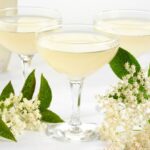Elderflower Champagne
Servings 3 bottles
Ingredients
- 300g g caster sugar
- 2 tbsp apple cider vinegar or white wine
- 2 lemons zested and sliced
- 15 elderflower heads
- 2 l water
- 5 g champagne yeast optional
Instructions
- Pick your elderflowers and leave them outside on a tea towel (in the shade), so that any potential bugs crawl away. Don't wash them, as this would damage the pollen and the natural yeast bacteria.
- Heat the water and sugar in a pan and stir until the sugar has disolved. Leave to cool and then transfer to a plastic container with a lid.
- Add the lemon zest, vinegar and the lemon slices. Stir slowly and loosely close with a lid.
- Leave to ferment in a room temperature for 48 hrs and check regularly for any signs of fermentation/yeast activity. Your elderflower mixture should start to bubble within 48 hrs. Open the lid and stir couple of times a day to introduce more new air bacteria.
- If you don't see any bubbles within 48 hrs, you can add some champagne yeast. This is optional.
- Pour the elderflower liquid through a muslin cloth (or a fine strainer) to a bottle or a fresh plastic container leaving about 5-6 cm (2 inch) from the top to allow for further fermentation. Loosely cover with a lid. Discard the elderflower heads.
- Leave to ferment for another 3-4 days before bottling the elderflower champagne to smaller glass bottles leaving at least 3 cm gap from the lid/bottle stopper. Check every day to let any gas pressure out.
- Leave for further 5-7 days to develop in the cold environment (or longer), before chilling in the fridge and enjoying your elderflower champagne with your summer picnic or garden party.
